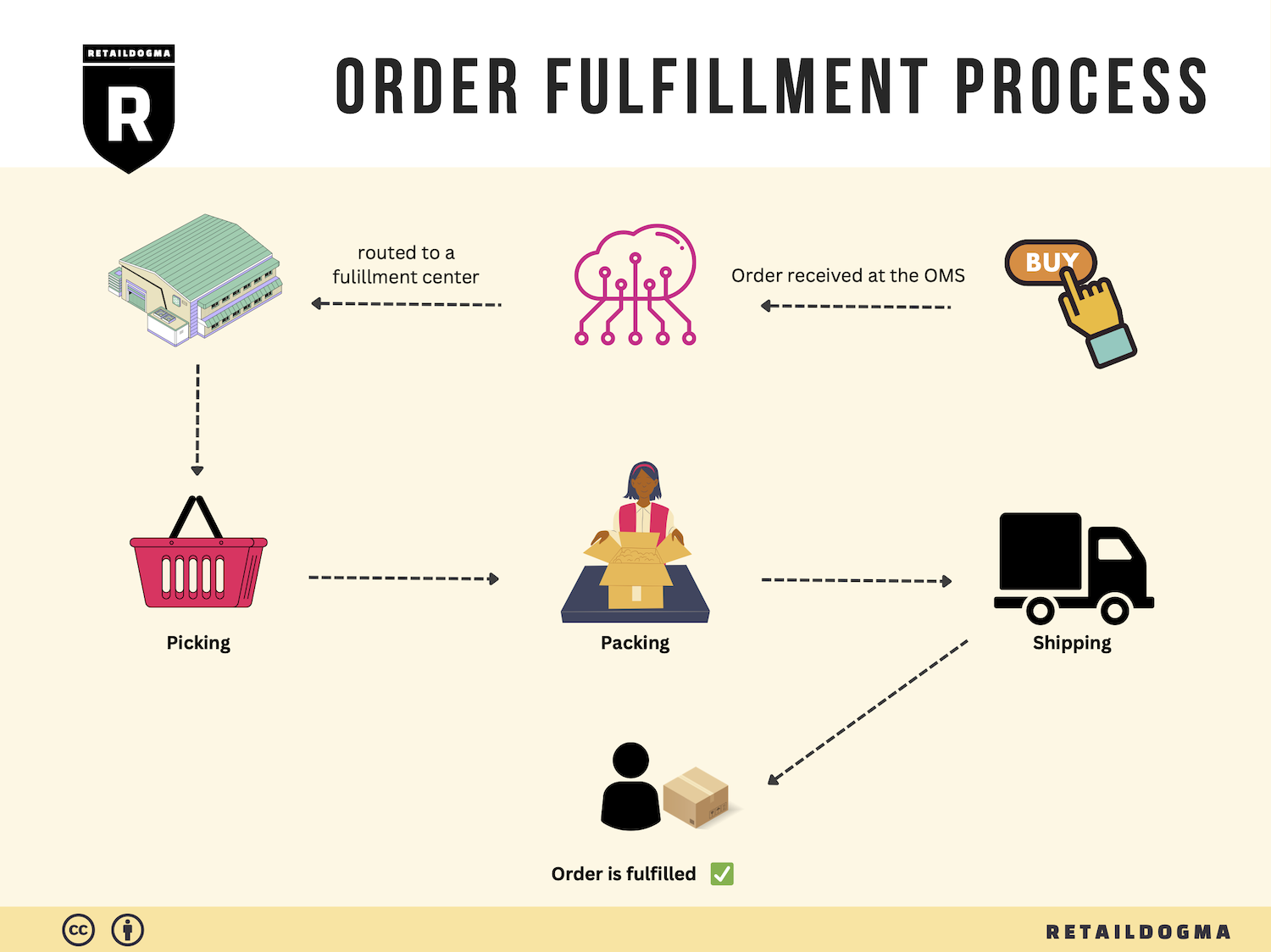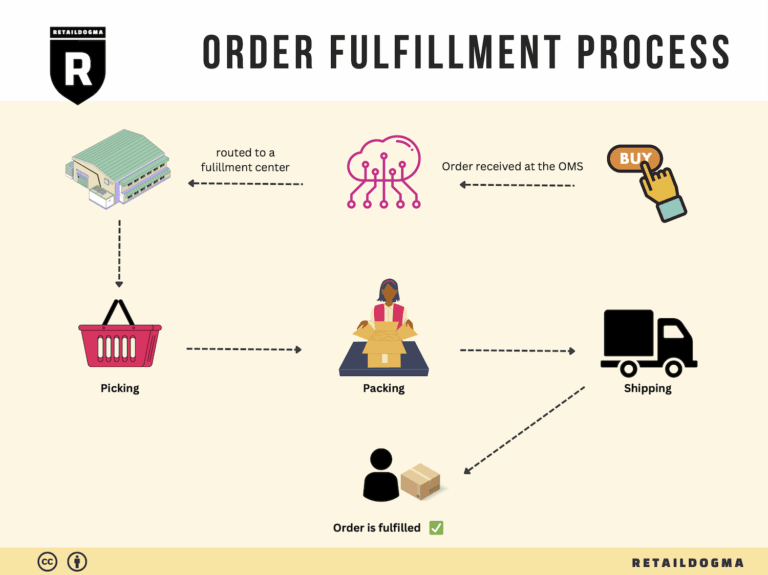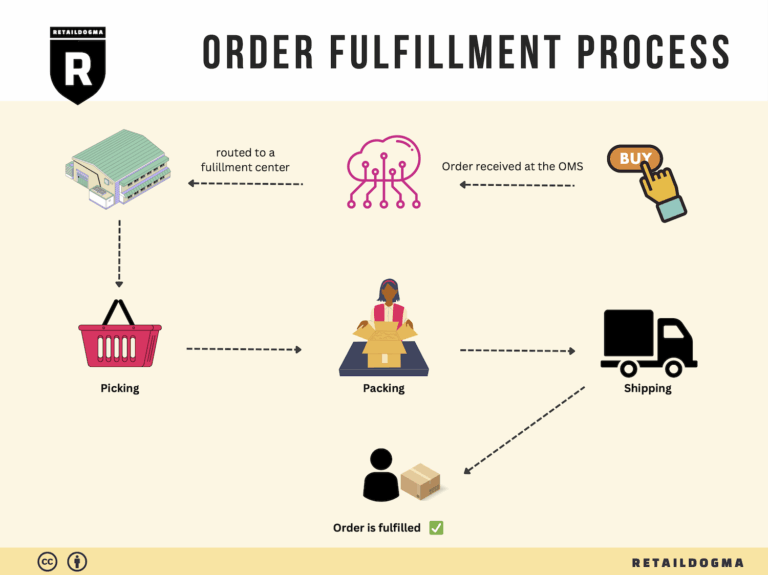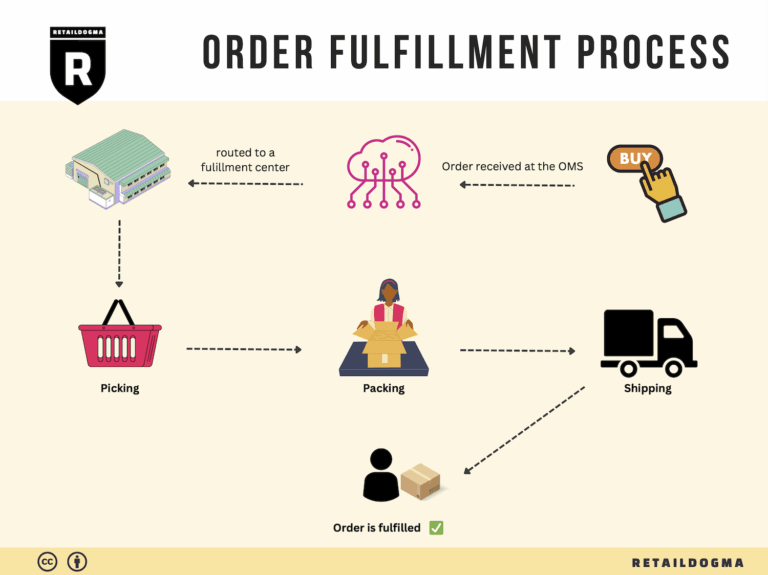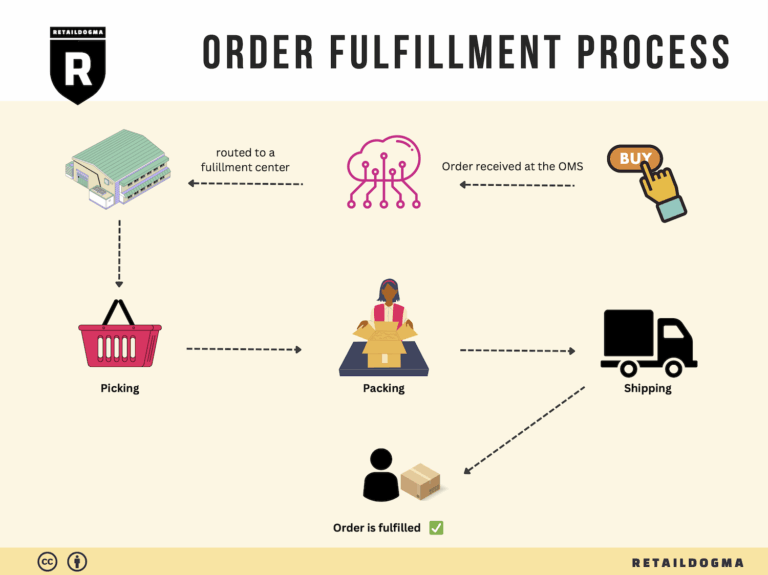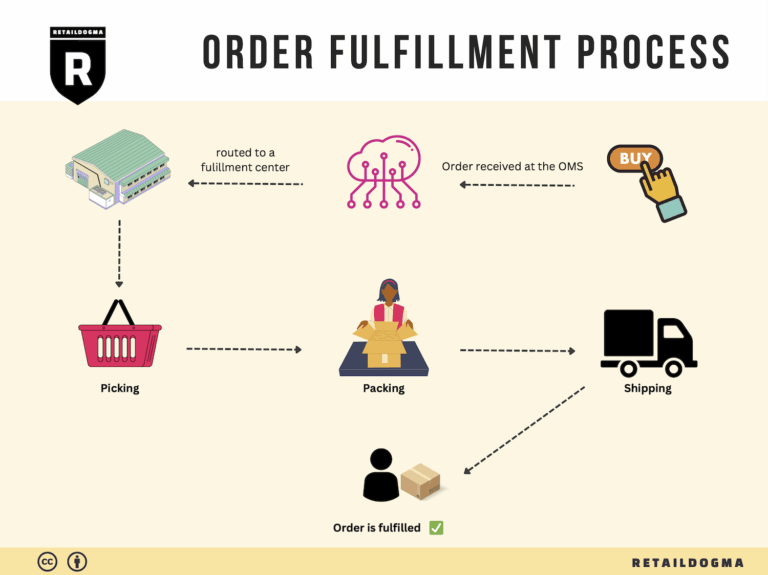What Is A Fulfillment Center? A Complete Guide (2025)
What is E-commerce Fulfillment? An Introduction for Growing Businesses
Understanding the Fulfillment Process
As an e-commerce business owner, you may find yourself overwhelmed with the day-to-day tasks of packing and shipping orders, especially as your business begins to scale. The excitement of increased sales can quickly turn into frustration when logistics become complicated, leading to delayed shipments and customer dissatisfaction. This is where the concept of e-commerce fulfillment comes into play.
E-commerce fulfillment is the comprehensive process of getting a product from your inventory to the hands of your customer. It encompasses everything from receiving and storing inventory, picking and packing orders, to shipping them out and managing returns. As your business grows, an efficient fulfillment strategy becomes critical to maintaining customer satisfaction and operational efficiency.
This guide aims to demystify e-commerce fulfillment for growing businesses by exploring various fulfillment models, including third-party logistics (3PL) and Fulfillment by Amazon (FBA). Each model offers unique advantages and can be tailored to suit your specific business needs. For instance, partnering with a 3PL provider allows you to outsource your entire logistics operation, freeing up your time to focus on core business activities, while FBA enables you to leverage Amazon’s extensive distribution network.
We will also delve into the core services offered by fulfillment partners, such as inventory management, order processing, shipping logistics, and returns management. Understanding these services will help you identify what you need from a fulfillment partner to meet your business goals and customer expectations.
Choosing the right fulfillment partner is a pivotal decision that can significantly impact your business’s success. This guide will provide practical insights on evaluating potential partners based on factors like location, service offerings, technology integration, and pricing models. We will outline how to assess your specific needs and match them with a fulfillment solution that aligns with your growth strategy.
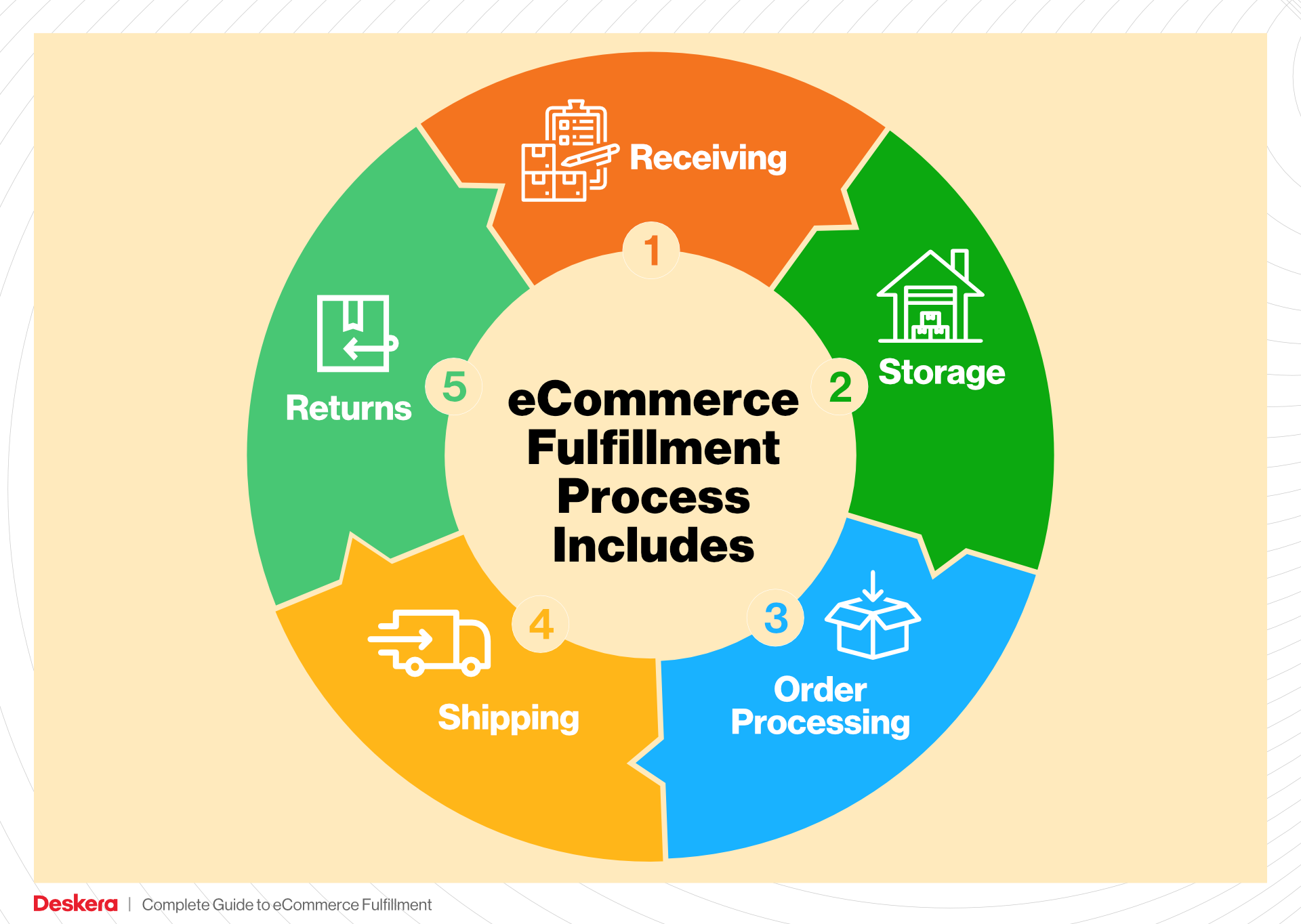
Finally, we will address pricing considerations, helping you to understand the cost structures associated with different fulfillment models and how to budget for them effectively.
The ultimate goal of this guide is to empower you with the knowledge to make informed decisions about your logistics. By understanding the various facets of e-commerce fulfillment, you can streamline your operations, enhance customer satisfaction, and position your business for sustainable growth.
What You’ll Learn In This Guide
- What is E-commerce Fulfillment? An Introduction for Growing Businesses
- The Order Fulfillment Process: From ‘Buy’ Button to Customer’s Door
- Comparing Fulfillment Models: In-House vs. 3PL vs. Dropshipping
- A Deep Dive into Amazon FBA: Pros, Cons, and Who It’s For
- Core Services Offered by Fulfillment Centers
- How to Choose a Fulfillment Partner: A 6-Point Checklist
- Understanding Fulfillment Pricing: A Breakdown of Common Fees
- Frequently Asked Questions (FAQs) about Fulfillment
- Conclusion: Is Outsourcing Fulfillment the Right Move for Your Business?
- Important Disclaimer
The Order Fulfillment Process: From ‘Buy’ Button to Customer’s Door
1. Receiving Inventory
The order fulfillment process begins with receiving inventory from suppliers or manufacturers. This step involves checking incoming shipments against purchase orders to ensure accuracy in quantity and quality. Key activities during this phase include inspecting the goods for damage, verifying SKU (Stock Keeping Unit) numbers, and recording the items into the inventory management system.
Importance: Accurate receiving is critical as it sets the foundation for inventory management. Errors at this stage can lead to stock discrepancies, fulfillment delays, and ultimately affect customer satisfaction. Implementing a robust receiving process helps prevent these issues and ensures that inventory levels are accurately reflected in your system.
2. Warehouse Storage
Once inventory has been received and verified, it is then stored in the warehouse. This step involves organizing products in a way that maximizes space and facilitates efficient retrieval. Depending on the type of products, they may be stored on shelves, in bins, or using pallet racking systems. Effective warehouse management systems (WMS) can automate this process, assigning locations based on item characteristics and sales velocity.
Importance: Proper storage is essential for optimizing space and reducing the time spent locating products. By organizing inventory strategically, businesses can enhance picking efficiency and minimize the risk of errors. Additionally, a well-structured storage system can improve inventory accuracy and facilitate easier stocktaking.
3. Order Picking
When a customer places an order, the next step is order picking, which involves retrieving the correct items from storage based on the order details. This process typically utilizes pick lists—documents or digital displays that outline the items and quantities to be collected. Different picking methods can be employed, including single order picking, batch picking, or zone picking, depending on the volume of orders and warehouse layout.
Importance: Efficient order picking is crucial for timely fulfillment. The faster and more accurately items are picked, the quicker orders can be processed and shipped. Errors in this step can lead to incorrect shipments, resulting in returns and dissatisfied customers. Implementing technology, such as barcode scanning or RFID, can significantly enhance accuracy and speed in the picking process.
4. Order Packing
After items are picked, they move to the packing stage. This involves carefully packaging the products to ensure they arrive at the customer’s door in perfect condition. Packing materials such as boxes, cushioning, and labels are selected based on the type of products being shipped. Additionally, businesses should include packing slips and any necessary documentation for returns or warranties.
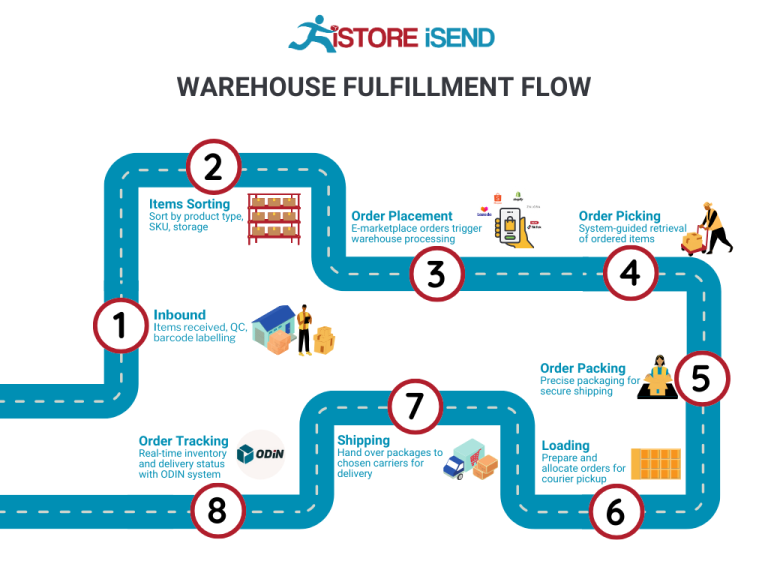
Importance: The packing process is vital for protecting products during transit and ensuring a positive unboxing experience for customers. Properly packed orders reduce the likelihood of damage during shipping, which can save costs associated with returns and replacements. Furthermore, an appealing presentation can enhance customer satisfaction and encourage repeat purchases.
5. Shipping & Delivery
The final step in the fulfillment process is shipping and delivery. Once orders are packed, they are labeled and handed over to shipping carriers for delivery. This step includes selecting the most cost-effective and timely shipping options based on customer preferences and order size. Tracking information is often provided to customers, allowing them to monitor their shipment.
Importance: Timely and reliable delivery is a key factor in customer satisfaction and retention. Efficient shipping processes can help businesses compete in a market where consumers expect quick delivery times. Additionally, providing tracking information enhances transparency and builds trust with customers. By analyzing shipping data, businesses can also identify trends and optimize their logistics strategy for future orders.
In summary, understanding and optimizing each step of the order fulfillment process is essential for e-commerce businesses looking to scale. By ensuring accuracy and efficiency from receiving inventory to delivering products to customers, businesses can improve operational performance and enhance customer satisfaction, ultimately driving growth in a competitive market.
Comparing Fulfillment Models: In-House vs. 3PL vs. Dropshipping
Comparing Fulfillment Models
| Model | Who Handles Inventory | Best For (Business Stage) | Key Advantage | Key Disadvantage |
|---|---|---|---|---|
| In-House Fulfillment | Business Owner/Employee | Startups to Medium Businesses | Full control over inventory and processes | High overhead costs and labor demands |
| Third-Party Logistics (3PL) | 3PL Provider | Growing to Established Businesses | Scalability and expertise in logistics | Less control over fulfillment process |
| Dropshipping | Supplier/Vendor | Startups to Small Businesses | Low upfront investment and risk | Lower profit margins and longer shipping times |
In-House Fulfillment
In-house fulfillment involves managing all aspects of inventory and order processing internally. This model is suitable for startups and medium-sized businesses that want to maintain complete control over their fulfillment process. By handling inventory themselves, these businesses can tailor their operations to meet specific customer needs, ensuring that product quality and order accuracy are prioritized. Additionally, in-house fulfillment allows for immediate adjustments to inventory levels and order processing, enabling companies to respond quickly to market changes.
However, the in-house model comes with significant disadvantages. The costs associated with maintaining warehouse space, hiring staff, and investing in packing and shipping materials can quickly escalate. Moreover, as order volumes grow, businesses may find it challenging to scale operations without incurring substantial additional costs. This model requires a strong commitment of time and resources, which can divert attention from core business activities such as marketing and customer engagement.
Third-Party Logistics (3PL)
Third-party logistics (3PL) providers specialize in managing inventory and fulfillment for e-commerce businesses. This model is ideal for companies that are in the growth phase or are already established and looking to scale their operations without investing heavily in infrastructure. 3PLs offer comprehensive services, including warehousing, picking, packing, shipping, and returns management, allowing businesses to leverage their expertise and technology.
The key advantage of using a 3PL is scalability. As order volumes increase, 3PL providers can quickly adapt to meet demand without requiring businesses to invest in additional warehousing or staff. Furthermore, many 3PLs offer integration with e-commerce platforms, enabling seamless order processing and real-time inventory management. However, the downside is that businesses may lose some control over their fulfillment processes. Relying on an external provider means that any issues with order processing or shipping may not be addressed as quickly as they would be in-house, potentially impacting customer satisfaction.
Dropshipping
Dropshipping is a fulfillment model where the retailer does not keep products in stock but instead transfers customer orders directly to the supplier, who then ships the products directly to the customer. This model is particularly attractive for startups and small businesses due to its low upfront investment and minimal risk. Entrepreneurs can offer a wide range of products without the need to invest in inventory, warehousing, or fulfillment staff.
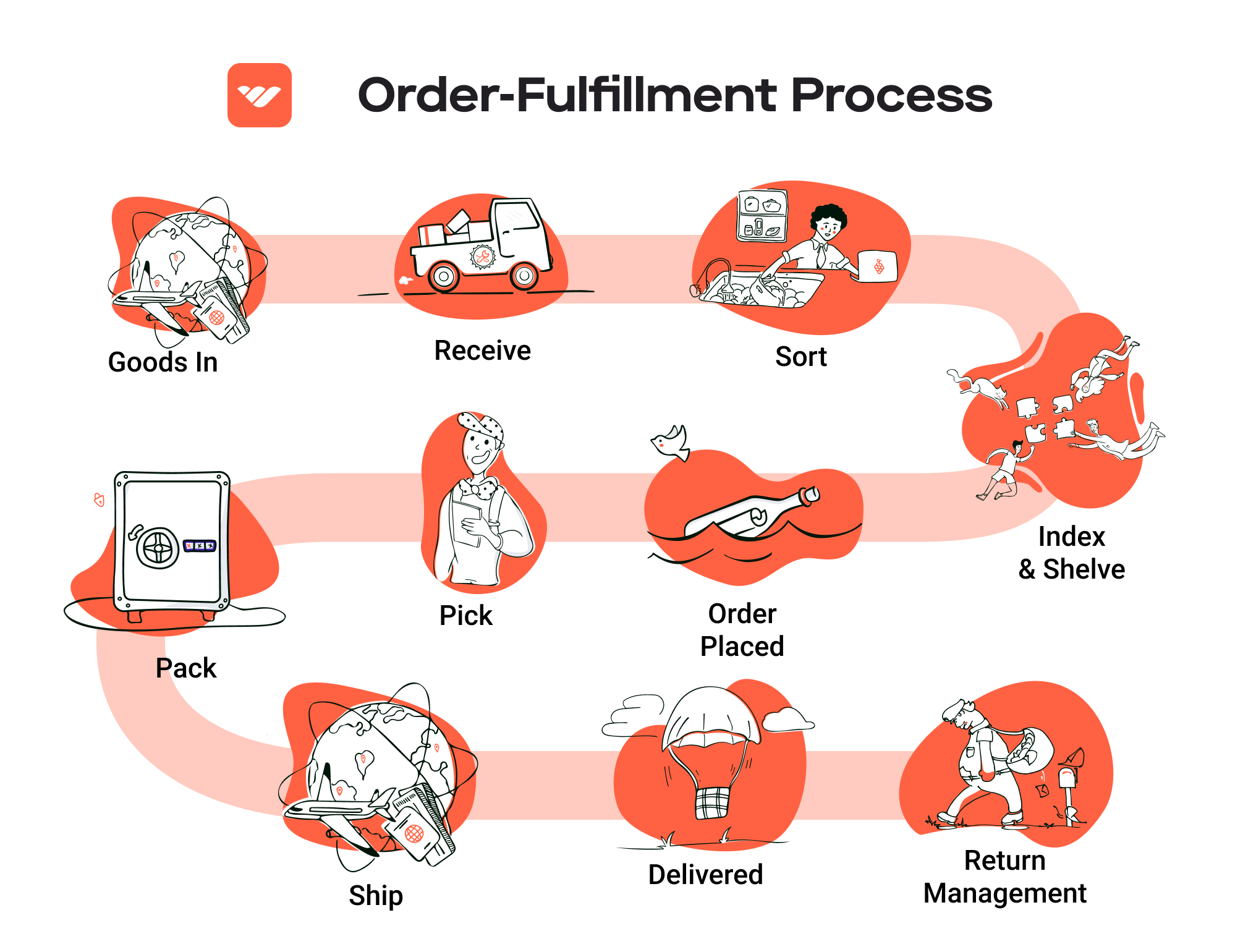
One of the main advantages of dropshipping is the low financial barrier to entry. Retailers can test various products and markets without committing significant resources. Additionally, dropshipping allows for a flexible business model where retailers can quickly pivot based on customer demand or trends. However, this model also comes with challenges. Profit margins are often lower since suppliers take a cut of the sale, and retailers have less control over shipping times and product quality, which can lead to customer dissatisfaction. Furthermore, reliance on suppliers means that any delays or issues on their end can directly affect the retailer’s reputation and customer experience.
In summary, choosing the right fulfillment model depends on your business stage, operational capabilities, and growth ambitions. Each model has its unique advantages and challenges, and understanding these can help e-commerce business owners make informed decisions that align with their strategic goals.
A Deep Dive into Amazon FBA: Pros, Cons, and Who It’s For
Understanding Fulfillment by Amazon (FBA)
Fulfillment by Amazon (FBA) is a service that allows e-commerce sellers to store their products in Amazon’s fulfillment centers. Amazon takes care of storage, packaging, shipping, and customer service for these products. This model enables sellers to leverage Amazon’s vast logistics network and customer base, potentially leading to increased sales and streamlined operations.
How FBA Works
-
Setting Up: Sellers create an Amazon seller account and enroll in FBA. They must prepare their products according to Amazon’s guidelines and ship them to designated fulfillment centers.
-
Storage: Once Amazon receives the inventory, it is stored in their warehouses. Sellers can track their inventory levels through the Amazon Seller Central dashboard.
-
Order Fulfillment: When a customer places an order, Amazon handles the picking, packing, and shipping of the product. This process is typically fast, as items are shipped from strategically located warehouses.
-
Customer Service: Amazon manages all customer inquiries and returns related to FBA products, providing a consistent level of service that many customers trust.
-
Payment: After the sale, the seller receives payment from Amazon, minus any applicable fees.
Pros of FBA
-
Prime Eligibility: Products fulfilled through FBA are automatically eligible for Amazon Prime, which can significantly boost visibility and sales. Prime members often prefer Prime-eligible items due to faster shipping options, enhancing the likelihood of purchase.
-
Customer Trust: Amazon’s established reputation for reliability and customer service can transfer to sellers using FBA. Customers may feel more confident purchasing from sellers whose products are fulfilled by Amazon, as they expect a certain standard of service.
-
Multi-Channel Fulfillment: FBA allows sellers to fulfill orders not only from Amazon but also from other sales channels, such as their own website or other marketplaces. This flexibility can streamline operations and enhance overall efficiency.
-
Scalability: As sales grow, FBA can accommodate increased inventory without the need for sellers to invest in warehousing or logistics infrastructure, making it easier to scale the business.
-
Efficient Returns Management: Amazon handles returns for FBA products, making the process easier for sellers and enhancing customer satisfaction. This can lead to better reviews and repeat business.
-
Time Savings: By outsourcing logistics to Amazon, sellers can focus on other aspects of their business, such as marketing, product development, and customer engagement.
Cons of FBA
-
High Fees: While FBA offers many advantages, it comes with costs. Sellers incur storage fees, fulfillment fees, and additional charges for services such as long-term storage or returns. These fees can cut into profit margins, especially for low-cost items.
-
Strict Inventory Rules: Amazon has specific requirements regarding inventory management, including guidelines on labeling, packaging, and storage. Failure to comply with these rules can result in penalties or removal of inventory.
-
Commingling Risks: Amazon may commingle inventory from different sellers, which means that the exact product sent to a customer may not be from the seller’s stock. This can lead to issues with quality control and brand integrity, particularly if another seller’s products are subpar.
-
Limited Control: When using FBA, sellers relinquish some control over the fulfillment process, including how products are packaged and shipped. This may not align with a seller’s brand identity or customer expectations.
-
Inventory Management Challenges: Sellers must keep a close eye on inventory levels to avoid stockouts or excess inventory, both of which can lead to lost sales or additional fees. This requires careful planning and forecasting.
-
Dependency on Amazon: Relying heavily on FBA can create a dependency on Amazon’s platform, which may pose risks if policies change or if the seller’s account faces issues.
Who is FBA Best For?
Fulfillment by Amazon is best suited for:
-
Small to Medium-Sized Sellers: Businesses that lack the resources or infrastructure to manage their own logistics can benefit significantly from FBA, allowing them to compete with larger sellers.
-
Sellers with High Sales Volume: Those who anticipate selling a high volume of products can leverage FBA to efficiently handle order fulfillment and customer service.
-
Sellers of Consumer Goods: Products that are popular, have a steady demand, or can benefit from Prime eligibility are ideal candidates for FBA.
-
Entrepreneurs Looking to Scale: For those aiming to grow their e-commerce business rapidly without investing heavily in logistics, FBA offers an attractive solution.
-
Multi-Channel Sellers: Businesses selling on multiple platforms can utilize FBA to simplify fulfillment across channels while maintaining a consistent customer experience.
In conclusion, while Fulfillment by Amazon offers significant advantages that can enhance a seller’s business, it is crucial to weigh these benefits against the potential downsides, including costs and operational challenges. Understanding your business needs and customer expectations will help determine if FBA is the right choice for your e-commerce venture.
Core Services Offered by Fulfillment Centers
Inventory Management & Warehousing
Inventory management and warehousing are foundational services provided by fulfillment centers, ensuring that e-commerce businesses can efficiently store and manage their products. This involves the systematic tracking of stock levels, order processing, and storage in a facility optimized for quick access and distribution.
What It Is:
Fulfillment centers maintain a dedicated warehouse space where products are stored until they are sold. Advanced inventory management systems (IMS) are employed to monitor stock levels in real-time, helping businesses avoid both overstock and stockouts. These systems often integrate seamlessly with e-commerce platforms, allowing for automated updates and inventory tracking.
Benefits:
1. Cost Efficiency: By utilizing a fulfillment center, businesses can save on overhead costs associated with maintaining their own warehouses, including rent, utilities, and staffing.
2. Scalability: As demand fluctuates, fulfillment centers can quickly adjust storage space and services, allowing businesses to scale their operations without the hassle of managing physical space.
3. Focus on Core Business: Outsourcing inventory management allows e-commerce owners to concentrate on marketing, product development, and customer service, rather than logistics.
Pick and Pack Services
Pick and pack services are essential components of order fulfillment, directly impacting the efficiency and accuracy of the shipping process. This service involves selecting the right items from the warehouse (picking) and preparing them for shipment (packing).
What It Is:
When an order is placed, fulfillment center staff pick the ordered items from their designated storage locations. Once picked, these items are packed securely using appropriate packaging materials to ensure safe transit. This process may also include labeling and documentation, depending on the shipping requirements.
Benefits:
1. Speed and Accuracy: Fulfillment centers specialize in quick and accurate order processing, which enhances customer satisfaction through timely deliveries. This is particularly important during peak shopping seasons.
2. Reduced Errors: Professional pick and pack services help minimize mistakes in order fulfillment, which can lead to returns and customer dissatisfaction. Advanced technology, such as barcoding and scanning systems, further ensures accuracy.
3. Customizable Packing Options: Many fulfillment centers offer customization in packing, allowing businesses to include promotional materials, branded packaging, or personalized messages, thereby enhancing the customer experience.
Kitting and Assembly
Kitting and assembly services enable e-commerce businesses to offer bundled products or customized orders without the logistical burden of managing these processes in-house. This service is particularly beneficial for companies that sell products requiring assembly or combination.
What It Is:
Kitting involves assembling various items into a single package or kit, which is then sold as one product. This can include anything from gift sets to complex product configurations that require assembly before shipping. Fulfillment centers have the expertise and resources to perform these tasks efficiently.
Benefits:
1. Enhanced Product Offerings: Kitting allows businesses to create unique product offerings that can differentiate them from competitors. Bundled products can increase average order value and encourage upselling.
2. Streamlined Operations: By outsourcing kitting and assembly, businesses can save time and resources that would otherwise be spent managing these processes in-house. This enables quicker response to market trends and customer demands.
3. Quality Control: Fulfillment centers often have quality control measures in place to ensure that kitted products meet specific standards before they are shipped, reducing the likelihood of returns due to assembly errors.
Returns Management (Reverse Logistics)
Returns management, or reverse logistics, is a crucial service that addresses the complexities of product returns. With the rise of e-commerce, effective returns management has become increasingly important for maintaining customer satisfaction and loyalty.
What It Is:
Returns management encompasses the processes involved in handling returned merchandise, from receiving returned items to restocking or disposal. Fulfillment centers typically have established protocols for managing returns, including assessing the condition of returned items and processing refunds or exchanges.
Benefits:
1. Customer Satisfaction: Efficient returns management enhances the customer experience by simplifying the return process, which can lead to increased customer loyalty and repeat purchases. A hassle-free return policy is often a deciding factor for online shoppers.
2. Cost Reduction: Fulfillment centers can optimize the return process, reducing the costs associated with handling returns, including shipping and restocking. They can also manage refurbishing or recycling of returned items, maximizing asset recovery.
3. Data Insights: Effective returns management provides valuable insights into customer behavior and product performance. Analyzing return data can help businesses identify trends, improve product offerings, and refine marketing strategies.
In summary, fulfillment centers offer a range of core services that are essential for e-commerce businesses looking to scale. By leveraging these services, businesses can improve efficiency, reduce costs, and enhance customer satisfaction, all of which are vital for success in the competitive online marketplace.
How to Choose a Fulfillment Partner: A 6-Point Checklist
Location & Warehouse Network
Why It Matters:
The geographical location of your fulfillment partner’s warehouses significantly impacts shipping times and costs. A well-placed warehouse network can reduce delivery times and improve customer satisfaction, especially in regions with high order volumes.
Questions to Ask:
– Where are your fulfillment centers located, and how does this impact shipping times to my primary customer base?
– What is the average delivery time for orders shipped from your warehouses?
– Do you have multiple locations to ensure coverage across key markets?
– How do you handle international shipping if my business expands globally?
Technology & Integrations
Why It Matters:
In today’s e-commerce landscape, technology plays a crucial role in managing inventory, orders, and customer communication. A fulfillment partner with robust technological capabilities can provide real-time tracking, automated inventory updates, and seamless integration with your e-commerce platforms.
Questions to Ask:
– What order management system (OMS) do you use, and how does it integrate with popular e-commerce platforms (e.g., Shopify, WooCommerce, Amazon)?
– Can I access real-time data and analytics about my inventory and orders?
– Do you offer a fulfillment portal for easy tracking and reporting?
– How do you handle system outages or technical issues?
Specializations (e.g., Cold Storage, Oversized Items)
Why It Matters:
Depending on the nature of your products, you may require specialized services. Whether you need cold storage for perishables or facilities that can handle oversized items, choosing a partner with the right capabilities can save you time and money while ensuring compliance with industry standards.
Questions to Ask:
– What types of specialized storage and handling services do you offer?
– Do you have experience handling my specific product type?
– How do you ensure compliance with regulations related to specialized products?
– Can you accommodate seasonal fluctuations in inventory for specialized items?
Scalability & Capacity
Why It Matters:
As your business grows, your fulfillment needs will evolve. A partner that can scale with your operations is crucial to avoid service disruptions during peak seasons or unexpected growth periods. Understanding their capacity and flexibility helps ensure you won’t outgrow your partner too quickly.
Questions to Ask:
– What is your current capacity, and how do you handle increased order volumes?
– Can you support seasonal spikes in demand (e.g., holidays, sales events)?
– How do you manage inventory overflow or excess stock during slower periods?
– What are your plans for expansion in the coming years?
Pricing and Contracts
Why It Matters:
Transparent pricing is essential for budgeting and ensuring profitability. Understanding the fee structure—whether it’s per order, per item, or a flat monthly fee—will help you gauge overall costs. Additionally, flexible contract terms can prevent unnecessary long-term commitments that may not align with your business goals.
Questions to Ask:
– What is your pricing structure, and what factors influence costs?
– Are there any hidden fees (e.g., for storage, returns, or special handling)?
– What are the terms of the contract, and is there flexibility for renegotiation?
– Do you offer trial periods or month-to-month contracts to assess compatibility?
Customer Support & Reviews
Why It Matters:
Strong customer support is crucial for resolving issues quickly and maintaining a smooth operation. Additionally, customer reviews and testimonials can provide insights into the partner’s reliability, responsiveness, and overall service quality.
Questions to Ask:
– What customer support channels do you offer (e.g., phone, email, chat)?
– What are your average response times for support inquiries?
– Can you provide references or case studies from similar businesses?
– How do you handle complaints or issues that arise during the fulfillment process?
Conclusion
Choosing the right fulfillment partner is a critical decision that can significantly affect your e-commerce business’s success. By following this checklist and asking the right questions, you can make an informed choice that aligns with your operational needs and growth ambitions. A strategic partnership in fulfillment can enhance your efficiency, customer satisfaction, and ultimately, your bottom line.
Understanding Fulfillment Pricing: A Breakdown of Common Fees
Initial Setup Fees
When partnering with a fulfillment center, initial setup fees are often charged to cover the cost of integrating your e-commerce system with the fulfillment provider’s technology. This fee can vary widely depending on the complexity of the integration and the specific services you require. Common components of initial setup fees may include:
- Account Setup: This may involve creating your account in the fulfillment provider’s system.
- System Integration: Connecting your e-commerce platform (like Shopify, WooCommerce, or Amazon) with the fulfillment center’s Order Management System (OMS) to ensure seamless data transfer.
- Training: Some providers offer training sessions for your team on how to use their systems effectively.
These fees are typically one-time charges but can range from a few hundred to several thousand euros, depending on the provider and your specific needs.
Receiving Fees
Receiving fees are charged when the fulfillment center receives and processes your inventory. This fee usually covers the labor and resources required to unload, inspect, and store your products. The calculation of receiving fees can depend on several factors:
- Volume of Inventory: Higher volumes might lead to discounted rates, while smaller shipments may incur a higher per-unit charge.
- Condition of Goods: If products arrive damaged or require additional inspection, this can increase costs.
- Handling Requirements: Special handling for fragile or oversized items may also lead to higher fees.
Typically, receiving fees are charged per pallet or per item and can range from a few euros to over ten euros, depending on the complexity of the receiving process.
Storage Fees (per pallet/bin)
Storage fees are charged for the space your inventory occupies within the fulfillment center. These fees can vary based on:
- Storage Type: Some providers charge based on pallet space, while others may use bin-based pricing. Pallet storage is common for larger items, whereas bins are used for smaller products.
- Duration of Storage: Many fulfillment centers have tiered pricing based on the length of time your goods are stored. For example, there may be a lower rate for the first month and increased rates for longer durations.
- Seasonal Demand: During peak seasons, such as holidays, storage fees may increase due to heightened demand for warehouse space.
On average, storage fees can range from €10 to €30 per pallet per month, while bin storage might be priced lower, depending on the provider’s pricing structure.
Pick & Pack Fees (per item/order)
Pick and pack fees are charged for the labor involved in selecting items from inventory and preparing them for shipment. These fees can vary based on:
- Number of Items: Most fulfillment centers charge a base fee for picking an order, plus an additional fee for each item included in that order.
- Packaging Requirements: Custom packaging or special handling requirements can increase pick and pack fees.
- Order Complexity: Orders that require multiple items or special instructions may incur higher fees due to the additional time and effort required.
Typical pick and pack fees range from €1 to €3 per order for the base fee, with additional costs of €0.25 to €1 per item.
Shipping Fees
Shipping fees are typically one of the most significant costs in the fulfillment process. These fees are determined by:
- Shipping Method: Different carriers (e.g., DHL, UPS, FedEx) offer various shipping options, including standard, expedited, and same-day delivery, each with its own pricing structure.
- Destination: Costs can vary based on the distance from the fulfillment center to the customer’s address, with international shipping generally being more expensive than domestic.
- Package Size and Weight: Shipping costs are often calculated based on dimensional weight, which considers the volume of the package in addition to its actual weight.
Shipping fees can range from €5 to €50 or more per shipment, depending on the factors mentioned above.
Tips for Getting an Accurate Quote
- Provide Detailed Information: When requesting a quote, supply comprehensive details about your products, expected order volumes, and specific service needs.
- Ask About All Fees: Inquire about all potential fees, including setup, receiving, storage, pick and pack, and shipping fees, to avoid unexpected costs later.
- Negotiate Rates: Don’t hesitate to negotiate terms and rates, especially if you anticipate high volumes or long-term partnership potential.
- Review Contracts Carefully: Ensure you understand the terms of service and any hidden fees that may not be immediately apparent in initial discussions.
- Consider Seasonal Fluctuations: Discuss how peak seasons may affect pricing and ensure you have a clear understanding of any changes in fees during those times.
By understanding these common fulfillment pricing models and following these tips, you can make informed decisions that support the growth and efficiency of your e-commerce business.
Frequently Asked Questions (FAQs) about Fulfillment
1. What is fulfillment in e-commerce?
Fulfillment in e-commerce refers to the complete process of receiving, processing, and delivering orders to customers. This includes inventory management, order picking and packing, shipping, and handling returns. Efficient fulfillment is critical for customer satisfaction and operational scalability.
2. What’s the difference between a warehouse and a fulfillment center?
A warehouse is primarily a storage facility where goods are kept until needed. In contrast, a fulfillment center focuses on the processing and shipping of orders. Fulfillment centers are equipped with systems and processes to manage inventory, pick and pack orders, and handle shipping logistics efficiently.
3. What is a 3PL (Third-Party Logistics) provider?
A 3PL provider is a third-party company that offers logistics services, including warehousing, fulfillment, shipping, and returns management, to e-commerce businesses. Partnering with a 3PL allows businesses to outsource logistics, enabling them to focus on core activities like marketing and product development.
4. How much do fulfillment services cost?
The cost of fulfillment services can vary widely based on factors such as the volume of orders, the types of products, and the specific services required (e.g., storage, picking, packing, shipping). Typical pricing structures include a per-order fee, monthly storage fees, and additional charges for special services. It’s essential to obtain quotes from multiple providers to find the best fit for your budget.
5. When should I consider outsourcing my fulfillment?
You should consider outsourcing fulfillment if you are experiencing rapid growth, running out of inventory space, spending excessive time on packing and shipping, or if you ship over 1,000 orders per month. Outsourcing can help reduce costs, improve efficiency, and allow you to focus on your core business operations.
6. How can I maintain control over my fulfillment process when outsourcing?
To maintain control, choose a 3PL provider that offers a robust dashboard application and fulfillment portal. These tools provide real-time visibility into inventory levels, order statuses, and performance reports. Regular consultation calls with your provider can also help you stay informed and involved in the fulfillment process.
7. What are the benefits of using a fulfillment center in Spain?
Utilizing a fulfillment center in Spain can significantly reduce shipping times and costs, improve customer satisfaction, and enhance your ability to compete with local e-commerce giants like Amazon. It also allows you to manage returns effectively and cater to the distinct preferences of Spanish consumers.
8. How do I handle returns in the fulfillment process?
An effective returns management process is crucial for customer retention. Choose a fulfillment partner that offers streamlined returns services, including same-day refunds, efficient return-to-stock processes, and options for product refurbishment. This can help minimize costs and enhance customer loyalty.
9. What types of services can I expect from a fulfillment center?
Fulfillment centers typically offer a range of services, including inventory management, order picking and packing, shipping, returns processing, and even value-added services like kitting or assembly. It’s important to discuss your specific needs with potential providers to ensure they can meet your requirements.
10. How do I choose the right fulfillment partner?
Selecting the right fulfillment partner involves evaluating several factors: the provider’s location (to ensure fast shipping), the range of services offered, technology integration capabilities, pricing structures, and customer service reputation. It’s advisable to request case studies or testimonials from similar businesses to gauge their effectiveness.
Conclusion: Is Outsourcing Fulfillment the Right Move for Your Business?
The Strategic Advantage of Outsourcing Fulfillment
Outsourcing your fulfillment process can be a transformative decision for your e-commerce business. One of the most significant benefits is time savings. By delegating order processing, packing, and shipping to a specialized fulfillment partner, you can refocus your efforts on core business activities like marketing, product development, and customer engagement. This allows you to scale your operations more effectively, as you can handle increased order volumes without the need for additional warehouse space or labor investment.
Moreover, partnering with a fulfillment service provides you access to a wealth of expertise and resources. Established fulfillment centers come equipped with advanced technology, streamlined processes, and a deep understanding of logistics. This not only enhances your order accuracy and delivery speed but also helps you adapt to the dynamic demands of the e-commerce landscape. For instance, many fulfillment services offer real-time inventory management and data analytics, which can significantly improve your decision-making capabilities.
However, choosing the right fulfillment partner is crucial for sustainable growth. Look for a provider that aligns with your business goals, offers flexibility to accommodate your unique needs, and has a proven track record in your target market. The right partner will not only support your current operations but also empower you to adapt and thrive as your business evolves.
To determine if outsourcing fulfillment is the right move for you, conduct an audit of your current shipping processes. Assess your order volumes, fulfillment costs, and the time spent on logistics. This evaluation will help you identify inefficiencies and guide you toward a solution that can enhance your operational efficiency. Taking this proactive step could be the catalyst for your next phase of growth.
Important Disclaimer
⚠️ Important Disclaimer
The information in this guide is for educational purposes. Fulfillment services, pricing, and platform features change frequently. Always conduct your own due diligence and consult with providers directly before making business decisions.
